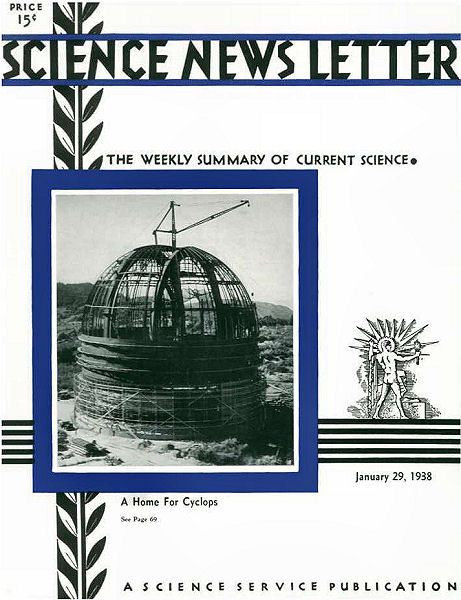From the January 29, 1938, issue

DOME FOR 200-INCH TELESCOPE IS NOW NEARING COMPLETION
The dome for the great 200-inch telescope on Mt. Palomar is practically finished structurally, and California Institute of Technology engineers can now breathe easier while completion and installation of equipment take place under its shelter during the next couple of years. By February 1, the dome itself will be complete.
The external shell is still to be painted outside and in with aluminum paint, miles of wiring for electrical circuits are still to be put into place, and of course the great telescope itself is far from completion.
Economical in size for the giant telescope it is to house, the dome covers about half an acre and is 137 feet in diameter. Above a cylinder 70 feet tall is a slotted hemisphere through which the telescope will look out at any angle with the horizon.
The upper part, including the hemisphere and 27 feet of the cylinder below it, can be rotated to any direction of the compass so that the instrument can see through the slot any part of the sky available in these latitudes.
FLICKERING PLANETOID COMES CLOSE TO EARTH
Eros, the 35-mile-long flickering planetoid, was only 20 million miles from the Earth last week. Turning over and over in space, exposing first its dull and then its shiny side, the coffin-shaped mass of cosmic junk kept about this distance for several days before starting its journey outward to beyond the orbit of Mars.
Discovered in 1898 by DeWitt of Berlin’s Urania Observatory, the little planetoid, one of many hundreds now known, has twice, in 1898 and 1931, come within about 16 million miles of the Earth.
Hermes, the half-mile-long celestial runaway which came within only 362,000 miles of the Earth last October, had now gone too far away to be seen.
It is believed that many, perhaps all, of the planetoids are not spherical but irregular in shape.
UNEARTH SIX CENTURIES OF PAINTING IN ANTIOCH FLOORS
A complete history of painting from the first to the sixth centuries after Christ has been discovered through excavation of a unique series of mosaic floors in houses in Antioch, Syria, it was announced at the annual meeting of the Archaeological Institute of America at Philadelphia, by Dr. F.O. Waage of the Department of Classics of Cornell University.
Dr. Waage exhibited for the first time photographs of the remarkable mosaics which were copies of long since destroyed paintings of early masters. Executed with remarkable craftsmanship, the mosaics retain the original color effects of the variegated bits of limestone, terra cotta, and glass which were used in their design.
Found by natives during the fall and winter and cleared and lifted by the expedition, several mosaic floors in the suburb of Antioch called Daphne are unusually important. One is a well-preserved panel of Narcissus, probably third century, and a striking panel of a striding lion set in an immense field of patterned flowerets, of the fifth century.
Another mosaic realistically shows the courses of a Roman banquet. One panel contains artichokes, pigs’ feet, eggs in egg cups, and bottles of wine.
Supported by the Worcester, Fogg, Baltimore, and Louvre, Paris, Museums and Princeton University, excavations have been carried on at Antioch during the past spring and summer and will be continued next year.







